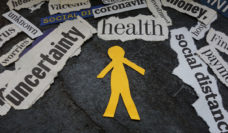Communities need objective Covid-19 metrics. The public wants to know what is happening and policy makers want reliable data to support evidence-based decision making. But the many formats in which health departments, data publishers, and the media represent morbidity and mortality can create confusion. The different definitions and formats create opportunities for manipulation. Moreover, these data often do not provide meaningful information on the pandemic’s disparate impact on disadvantaged populations. Sometimes it seems like we are lost in a sea of data!
Metrics are the result of a process that begins with testing. Case counts depend on individuals’ concerns about exposure and symptoms, their decisions to be tested, test availability and requirements, and other factors. Thus, there are drop-offs at every step, and the number of actual Covid-19 cases is 2 to 10 times higher than reported. The ratio changes over time and varies across jurisdictions. Metrics also depend on which tests “count,” for example, whether universities’ surveillance tests are included. Even Covid-19 hospitalization and death data depend on case definitions, whether a test was performed, physician decisions, and other factors.
Because comparisons are important for interpretation, current metrics can be improved by better coordination among data producers and publishers about how metrics are defined and what measures to report. Consistency is more important than “accuracy.” Ultimately, we a need a comprehensive approach to implement a uniform national framework for data generation, collection, analysis, and reporting to more accurately quantify disaster-related deaths, injuries, and illnesses.
Alternative data sources are also needed. The National Academies of Sciences, Engineering, and Medicine shows how population-based statistical estimates can complement case and death counts. While “estimation” sounds less precise than “counting,” these methods can provide a more comprehensive assessment of the pandemic’s impact. And because case data generated for operational purposes such as contact tracing may not contain demographic descriptors, estimates can provide more detailed information on disparities and social determinants of health.
Ultimately, this research can help us better understand, and eventually minimize the historic burden of disparities and inequities faced by the most vulnerable among us.
One approach is to conduct seroprevalence surveys in representative samples to determine how many in a community have been infected. The results from these surveys can be broken down by race, ethnicity, and other factors. Blood samples obtained for other clinical assessments can also be analyzed. And the Census Bureau’s Pulse Survey can help us understand the psychological, social, educational, and economic consequences of Covid-19, both in general and in different socio-demographic groups.
Excess mortality calculations, which are based on comparing the observed number of deaths in the pandemic period to an earlier time, include both direct (caused by a documented Covid-19 infection) and indirect deaths (for example, a heart attack victim unable to get care due to overcrowded emergency rooms). Therefore they typically provide the most complete estimates of Covid-19’s impact. For instance, the Economist calculates that, through September 14, 2021, there were 800–880 thousand excess deaths in the United States compared to the official count of 662 thousand, a 30% difference. This type of analysis shows that the pandemic hit Blacks and Hispanics especially hard. Covid-19 deaths were less likely to be classified as such in rural areas, the South, and in counties that supported Trump.
Just as with case data, statistical methods vary. Research is needed to specify methodological best practices and harness the federal government’s existing survey infrastructure so that, in times of national emergency, survey instruments can be immediately used to measure the overall impact of the pandemic from both a health and socio-economic perspective. Ultimately, this research can help us better understand, and eventually minimize the historic burden of disparities and inequities faced by the most vulnerable among us.
Photo via Getty Images














